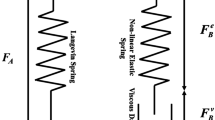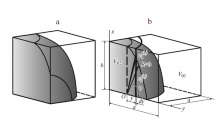Abstract
In this work, a model is developed which allows one to determine the thickness and properties of the interphase layer in unidirectional and filled composites, assuming that the materials of the interphase, matrix, and fillers may have a fractal structure, and to predict the properties of composites with interphases. Using a set of computer programs elaborated, the corresponding calculations are carried out for glass-epoxy composites, epoxy carboplastics, and graphite-filled epoxy polymers.
Similar content being viewed by others
REFERENCES
Yu. S. Lipatov, Physicochemical Principles of Filled Polymers [in Russian], Khimiya, Moscow (1991).
I. S. Deev and L. P. Kobetz, “Structure-forming in filled thermoreactive polymers,” Kolloid. Zh., 61,No. 5, 650–660 (1999).
V. U. Novikov and R. A. Tkalenko, “Modeling composites on graphs with parameters optimization,” Mech. Compos. Mater., 32, No. 4, 321–330 (1996).
L. T. Drzal, “The effect of polymeric matrix mechanical properties on the fiber-matrix interfacial shear strength,” Mater. Sci. Eng., A126,No. 2, 289–293 (1990).
P. Theocaris and E. Sideridis, “The elastic moduli of particulate-filled polymers,” J. Appl. Sci., 29,No. 10, 2997–3011 (1984).
W. Wu, I. Verpoest, and J. Varna, “A novel axisymmetric variational analysis of the stress transfer into fiber through a partially debonded interface,” Compos. Sci. Technol., 58,No. 12, 1863–1877 (1998).
W. Wu, E. Jacobs, I. Verpoest, and J. Varna, “Variational approach to the stress transfer problem through partially debonded interfaces in a three-phase composite,” Compos. Sci. Technol., 59,No. 4, 519–535 (1999).
W. Wu, I. Verpoest, and J. Varna, “An improved analysis of the stress in a single-fibre fragmentation test. Part II. 3-Phase Model,” Compos. Sci. Technol., 58, 41–50 (1998).
J. G. Williams, M. E. Donnellan, M. R. James, and W. H. Morris, “Properties of the interphase in organic matrix composites,” Mater. Sci. Eng., 126, No. 2, 305–312 (1990).
G. M. Gunyaev, The Structure and Properties of Polymer-Fiber Composites [in Russian], Khimiya, Moscow (1981).
V. D. Shabetnik, Fractal Physics. Science of the Universe [in Russian], Tibr, Moscow (2000).
M. Schroeder, Fractals, Chaos, Power Lows, W. H. Freeman and Co., New York (1997).
B. B. Mandelbrot, The Fractal Geometry of Nature, Freeman and Co., New York (1982).
V. U. Novikov, G. V. Kozlov, and O. Y. Buryan, “Fractal approach to the interphase in filled polymers,” Mech. Compos. Mater., 35, No. 1, 1–18 (2000).
V. U. Novikov, and G. V. Kozlov, “Structure and properties of polymers in terms of fractal approach,” Russ. Chem. Rev., 69,No. 6, 523–549 (2000).
V. U. Novikov and G. V. Kozlov, Analysis of the Failure of Polymers within the Framework of Fractal Approoach [in Russian], MGU, Moscow (2001).
I. Ya. Ladyzhinskii, “Colloidal fractal aggragates or a gel”? Kolloid. Khim., 54, No. 4, 80–86 (1992).
D. Avnir, D. Farin, and P. Pfeifer, “Molecular fractal surfaces,” Nature, 308,No. 5, 261–263 (1984).
V. A. Bagryanskii, V. K. Malinovskii, V. N. Novikov, L. M. Puschaeva, and A. P. Sokolov, “Inelastic diffusion of light on fractal vibration modes in polymers,” Fiz. Tverd. Tela, 30,No. 8, 2360–2366 (1988).
R. Rammal and G. Toulouse, “Random walks on fractal structures and percolation clusters,” J. Physiq. Lettr. (Paris), 44, No. 1, 13–22 (1983).
Yu. S. Lipatov, Interphase Phenomena in Polymers [in Russian], Kiev, Naukova Dumka (1980).
V. U. Novikov and O. Y. Buryan, “Modeling of the interphase in anisotropic composites,” Prikl. Fiz., No. 1, 67–73 (2000).
V. U. Novikov, A. V. Vlasov, and O. Y. Buryan, “The development of an interphase investigation strategy for hybrid polymer composites,” Materialovedenie, No. 1, 20–24 (1999).
H. G. E. Hentschel and J. M. Deutch, “Flory-type approximation for the fractal dimension of cluster-cluster aggregates,” Phys. Rev. A, 29, No. 12, 1609–1611 (1984).
P. Pfeifer, D. Avnir, and D. Farin, “Scaling behaviour of surface irregularity in the molecular domain: from adsorption studies to fractal catalysis,” J. Stat. Phys., 36, Nos. 5/6, 716 (1984).
D. Farin, S. Peleg, D. Yavin, and D. Avnir, “Applications and limitations of boundary-line fractal analysis of irregular surface: proteins, aggregates and porous materials,” Longmuir, No. 4, 399–407 (1985).
V. U. Novikov and G. V. Kozlov, “The physical base of the processes of energy dissipation under the impact tests of polymers,” Prikl. Fiz., No. 1, 77 (1997).
V. U. Novikov and G. V. Kozlov, “Fractal analysis of the elastic properties of disperse-filled composites,” in: Symp. “Sinergetika-96,” 12-14 November, 1996, Synergetics, Structure, and Properties of Materials. Pt. II [in Russian], Moscow (1996), p. 225.
S. Wu, “Chain structure and entanglement,” J. Polym. Sci. Pt. B: Polym. Phys., 27, No. 4, 723–741 (1989).
A. S. Balankin, Synergetics of Deforming Bodies. Pt. I [in Russian], MO SSSR, Moscow (1991).
A. I. Bobryshev, Synergetics of Composite Materials [in Russian], NPO “ORIUS,” Lipetsk (1994).
D. Avnir, D. Farin, and P. Pfeifer, “Surface geometric irregularity of particulate materials: the fractal approach,” J. Colloid. Interf. Sci., 103, No. 1, 112–123 (1985).
A. S. Balankin, “The theory of elasticity and entropial high-plasticity of fractals,” Zh. Eksperim. Tekh. Fiz., 17, No. 17, 68–72 (1991).
L. D. Landau and E. M. Lifshitz, The Theory of Elasticity [in Russian], Nauka, Moscow (1987).
E. H. Kerner, “The elastic and thermoelastic properties of composite media,” Proc. Phys. Soc., Sec. B, 69,808–813 (August, 1956).
V. A. Kochetkov, “Calculations of elastic characteristics and creep functions of hollow-sphere plastics by the effective medium method,” Mech. Compos. Mater., 30, No. 2, 121–130 (1994).
Z. Zlatev, “On some pivotal strategies in Gaussian elimination by sparse technique,” SIAM J. Numer. Anal., No. 17, 18–30 (1980).
Author information
Authors and Affiliations
Rights and permissions
About this article
Cite this article
Buryan, O.K., Novikov, V.U. Modeling of the Interphase of Polymer-Matrix Composites: Determination of Its Structure and Mechanical Properties. Mechanics of Composite Materials 38, 187–190 (2002). https://doi.org/10.1023/A:1016008432083
Issue Date:
DOI: https://doi.org/10.1023/A:1016008432083




